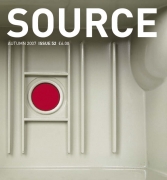EDITORIAL:
Issue 52 — Autumn 2007
Issue 52 — Autumn 2007
View Contents ▸
Where is photography now? Tate Britain has just hosted How We Are (review p.50) - an exhibition including not only art and documentary pictures, but even lowly forms of vernacular photography - which has been visited by 97,000 people. The BBC is about to broadcast a six part series, The Genius of Photography (review p.46), the most significant coverage of the medium on television since the 80s. There are more books and exhibitions of photography than ever. So many, in fact, that Richard West is able to survey some of the clichés that have arisen from this abundance (p. 32).
Photography appears to have been admitted finally to the most prestigious institutions and to be worthy of discussion in our most august forums. This acceptance, however, is an illusion. As Russell Roberts notes in his review of How We Are: it is art photography that has gained unlimited admission to the gallery, other forms are allowed in only if they are suitably presented and sufficiently old. Thirty years ago, art photography was a rare and exotic part of the photographic family, marginal to photography's other roles in the media, the home and industry. It would have been unlikely that a television series would have given it anything other than passing notice. Today it forms the almost exclusive focus of six hours of programming. And not only is the Genius of Photography 'art', it is also, as Daniel Jewesbury was disappointed to discover, 'constructed as heroic, driven, maverick, obsessive... and male' (p.46).
Geoffrey Batchen believes that this narrow view of photography as a subject is due to the influence of art history (p.22). He believes photography studies should be a type of visual culture that does justice to the breadth of photography's impact on human history. This would entail more than just the inclusion of vernacular photographs or the discovery of artistic radicalism: 'What we need now is an avant-garde form of history, not another obedient history of the avant-garde!'
Ironically, some of the photography excluded from these recent considerations of the medium has been made by people who have always referred to themselves as 'artists'. John Hilliard came to prominence in the 70s as part of a loose group - including Keith Arnett, Victor Burgin and Richard Long - who initially used photography as a tool to document sculpture and performance, but subsequently became interested in the medium's own powers of representation. In an extended interview and portfolio, Hilliard talks about recent developments in his work and what makes artists' photography different.
Like Hilliard, Mervyn Arthur has turned the camera on itself, but to different effect. His Camera Interiors at first appear to be images of architecture, and remind us that the basic unit of photography (and the very meaning of the word 'camera') is the room. In his Money column Michael Begg discusses the impact on high street photo labs of the growth in use of digital cameras. It's a trend that has also made a difference to David O'Mara whose previous work Days of Nothing (Source 25) relied on the reprinting of negatives lost or discarded in the street. In the digital era, as this material has became harder to find, he has switched to collecting other detritus - drawings, lists and maps - which he combines with photographs of his own, made on the way to and from work.
This issue marks the tenth anniversary of the death of former Source editor Patrick McCoy. His work, which is in the collection of The National Media Museum in Bradford, was most recently shown at Sirius Arts Centre, Cobh. A selection of his portraits from The People's Taxis is on permanent display at the West Belfast taxi headquarters and also forms part of the City as Archive project online at ww.belfastexposed.org. More details about Patrick's work including an essay by Ciaran Carson can be found on the Source website. We would like to dedicate this issue to his memory.
— The Editors





